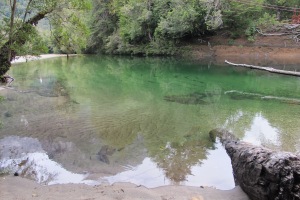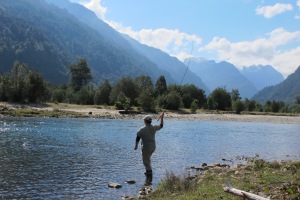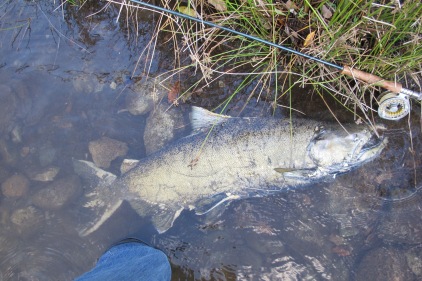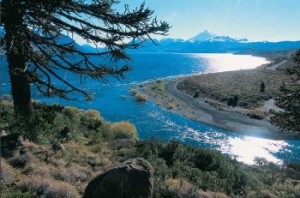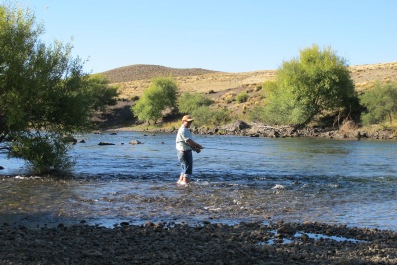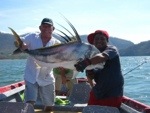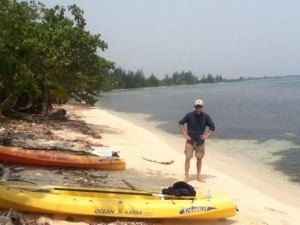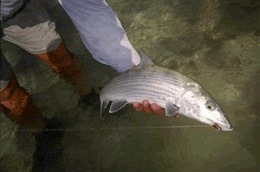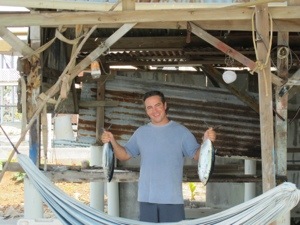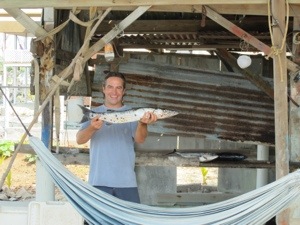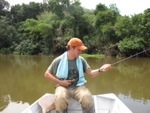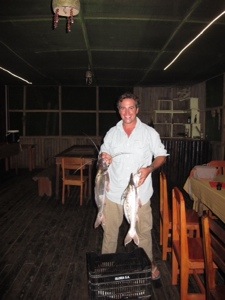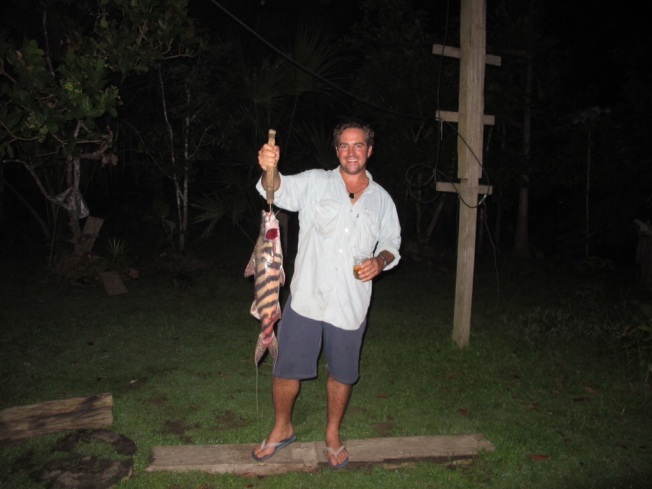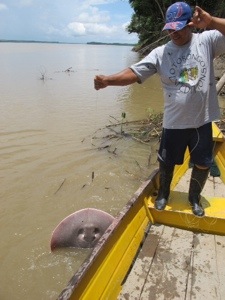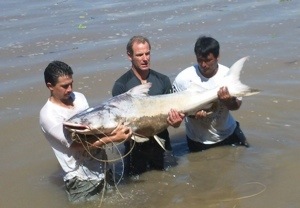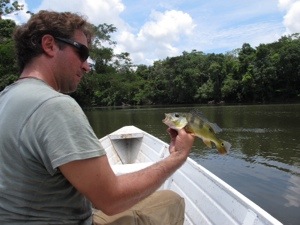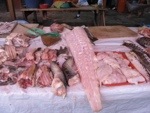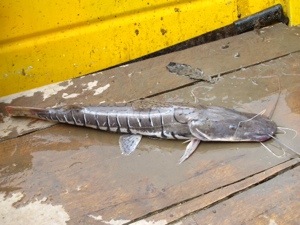Chile: In Butch Cassidys shadow
Salmon fly fishing paradise…
I have had the opportunity over the past year to fish in some truly memorable places, but none will stay with me as fondly as my trip to the ‘lake district’ of Chile.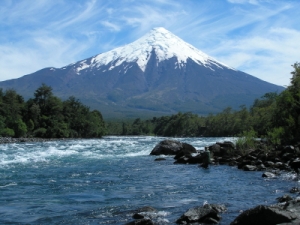
My research prior to my arrival in Osorno had pointed me in a number of directions and regions with the Rivers: Cochamo; Golgol; Huellelhue; Maulin; Petrohue; Puelo and Rahue amongst the favourites. Each river has their target species from the huge Brown Trout of the Puelo to the Atlantic & Chinook salmon on the Petrohue.
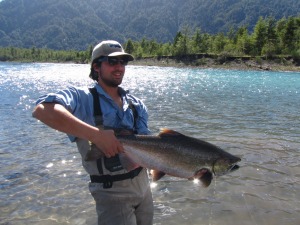 There are a plethora of companies set up locally to cater for the US anglers that come here en masse as the Mecca for Salmon fishers and choosing one to go with can be a daunting task. Due the explosive rise of recreational angling amongst Chileans, the goernment and participants in sport fishing are working together to make new laws to help regulate the fishing tourism industry and ensure its longevity. The regulations have hence got much tighter in recent years, with the necessity of having a fishing licence a must so it is worth checking in with one of the local fly fishing shops in Osorno if going solo.
There are a plethora of companies set up locally to cater for the US anglers that come here en masse as the Mecca for Salmon fishers and choosing one to go with can be a daunting task. Due the explosive rise of recreational angling amongst Chileans, the goernment and participants in sport fishing are working together to make new laws to help regulate the fishing tourism industry and ensure its longevity. The regulations have hence got much tighter in recent years, with the necessity of having a fishing licence a must so it is worth checking in with one of the local fly fishing shops in Osorno if going solo.
One of the reasons for Chile’s phoenix like re-emergence in the salmon world are the quantity and diversity of the Salmon species available at any one time. (You can quite literally catch both Rainbow & Brown trout in the morning and finish the day catching Chinook, King and Atlantic salmon! Surely there are no other places on the planet where this is possible!) Whilst other countries are struggling to show the catch records desired by enthusiastic anglers.
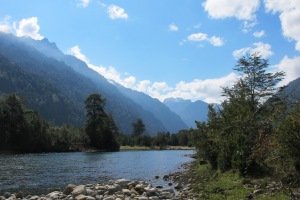
I myself had heard, (through some contacts made on Chiloe Island further south) about a lodge up in mountains, towards the Argentine border, where the upper reaches of the Cochamo River bustle past your cabin. Now normally you would expect this of most fishing lodges, along with electricity etc. but this one was only accessible by a 6 hour horse ride! To try and  describe the majestic scenery would be futile so instead I have had to resort to these photos and will try and post a video in due course. The pass into Argentina itself has the famous reputation of being where Butch Cassidy and the Sundance Kid drove their rustled cattle through to the distant Chilean markets.
describe the majestic scenery would be futile so instead I have had to resort to these photos and will try and post a video in due course. The pass into Argentina itself has the famous reputation of being where Butch Cassidy and the Sundance Kid drove their rustled cattle through to the distant Chilean markets.
After 6 days staying at Campo Adventura, both my wife & I were ready to ask Kurt, the owner, if we could take over for the next season.
In short, the days were spent riding through mountains, trekking to waterfalls and fishing the miles of deserted river banks.
The crystal clear Andean River Cochamo is chock full of very large King & Chinook Salmon… on one bend in the river I counted over 50 of these huge leviathans!! Unlike the Salmon I’ve watched in the UK, these were actively feeding, picture 40lb fish leaping out of the river to catch the huge dragon flies that hover aimlessly over the water. Quite simply breath-taking. The river is so clear that you can even stalk the fish and get within meters of them. Some of the bigger fish I caught, like the one below had obviously been spawning for some time whereas others where bright silver having swum from the fjords only days previously.
On a single handed 9‘9 weight you can have a great time trying to manoeuvre +40lb fish! One took me up to my waist down the river a good 200 yards, which without waders gave huge amusement to the lodge staff.
If you are ever heading down to Chile to sample the wines, visit the observatories or trek through the awesome national parks, I beg you, if you are a fishing enthusiast at least, to go and see these rivers for yourself.
Argentina: Patagonian Trout
Having finally reached San Carlos de Bariloche in Northern Patagonia I was itching to get further up into the mountains and drive through the stunning forests & lakes on route to Junin de los Andes and the fabled Chimehuín River.
After a brief pause to shake off the 21 hour bus journey from Mendoza and rent the sturdiest 4×4 I could find, I stocked up on chocolate from one the countless patisseries that line the streets in this mock Alpine town and got licences, flies & valuable information from the fly fishing store, Baruzzi http://www.barilochefishing.com/contacto_flyshop.php , near the central square.
An early start and 4 hours of driving took me past the 7 lakes the region is famous for and through San Martin de los Andes and on towards the dusty frontier-esq town of Junin de los Andes.

Snow melt from the Andes transforms into crystal clear water to create the 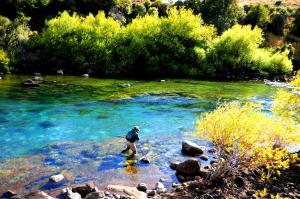 60 km long Chimehuin River. Known a one of the best rivers in the world for fly fishing, it is the habitat of large rainbows and browns who love its willow lined banks, big boulders and numerous pools.
60 km long Chimehuin River. Known a one of the best rivers in the world for fly fishing, it is the habitat of large rainbows and browns who love its willow lined banks, big boulders and numerous pools.
We stayed in a small hotel on the outskirts of town and spoke with the owner about my desire to fish without paying $200 a day. She immediately introduced me to her son, a local fishing guide, who had grown up on the river and knew many of the secret lays and pools that the majority of paying Anglers rarely see.
2 days were spent wading down kilometres of river catching 2 – 3lb browns and 5lb rainbows in challenging rapids and deep eddies. Although my guide was missing 3 fingers on his right hand he still showed me up with sublime casting to cover rising fish right under the far bank willow trees.
There are a number of Lodges further up towards the headwaters of the Chimehuin River in the shadow of the Lanin Volcano that offer complete fishing packages. Some of these even have hot tubs and massaging facilities! Regardless of where you are staying, to fish past dusk and then head to one of the Parillas in town for grilled steak and Malbec around a flaming log fire is an experience difficult to beat.
El Salvador: Gulf de Fonseca
The Pacific Coast is famous for Rooster Tails ( Pez de Gallo) and are only found from Mexico to Ecuador.
Kayaks are the preferred mode of transport and the rich waters of the Gulf de Fonseca create a ideal feeding ground for Tuna, Jacks, Spanish Mackerel, Rooster fish and much more. The Gulf itself is much shallower than the surrounding seas and barely reaches 200 meters meaning less pelagic fish and more food for the game fish.
The kayaking can be tiresome, going against the winds when navigating around the small islands that dot this region and sun lotion and lots of water is a must.
Richard, the owner of Hotel Joya, on Isla Meanguera is an avid fisherman and has an impressive array of fishing tackle for your disposal. Small spinner rigs for fishing from shore to deep sea rods for trawling and I spent many hours fishing from the hotels’ dock catching the Jacks that turn the sea into a boiling mass when feeding.
A 35lb Rooster fish was caught the week before I arrived but sadly I didn’t get a chance to see the tell-tail sign of its primary dorsal breaking the surface. I did hook into a decent Spanish Mackerel though that made me thankful I had my wire trace on the line and ended up as delicious sushi and ceviche for lunch!
Utila Kayak fishing for Tarpon
Of the 3 main Bay Islands in Honduras, Utila has the fewest flats for Bone-fishing. It is however easy to get to and a fraction of the price of Roatan or Guanaja.
As soon as we arrived I realised that Utila had far more to offer than I originally suspected as I saw a school of bonefish feeding off our little private dock… After duly setting up the fly rod and selecting a the appropriate fly I headed back to the pier only to find that the Bone-fish had been replaced with a very large Tarpon! I ran back to the fly box, tied on a large streamer and hurried back only to find 2 huge Permit circling only 30 foot in front of me… Torture!
The next few days were spent gathering as much information as possible from boat captains and old fisherman as to the best locations and local tactics… almost all involved large land crabs and mangroves on the north side of the island in an area known as Rock Harbour.
Together with another Scuba diver from Alaska, Christian, we set out at 3.30am one morning and headed to ‘Coral View’ Resort to collect some Kayaks for the 1 hour paddle through a canal across the entire island to the north side. The scenery is stunning and incredibly peaceful at that time of the morning, but the talk of Salt Water Crocs that used to inhabit the island did make for a wary journey through mangroves in the dark!
The canal
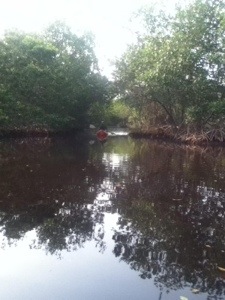
We appeared as dawn was breaking into the deserted Rock Harbour and 2 miles of flats going out to the reef.
The first ‘Bone’ was spotted within 5 mins of kitting up and the next 2 hours were spent stalking, casting and catching Bone-fish, Jacks, Grunts and at one point an angry and very strong Trunkfish that took me down to my backing.
By 10am we had worked our way East across a mile of flats towards an area know as ‘Jaggs Bight’, a small bay tucked away with a narrow entrance to the open ocean. Rods all strapped onto the kayaks, we headed out across the reef and the breaking waves to round the point into the bay. Open ocean kayaking isn’t for the faint hearted but surfing waves on a kayak with a fishing rod is surely only something you can do in the crystal waters of the Caribbean!
The rewards on of efforts were quickly realised when the fist few dorsal fins of Tarpons were spotted… Fly change time. The ‘Baby Tarpon’ in the bay were around 4 foot in length and feeding…aggressively, constantly breaching the water eating small bait fish. Christian had the 1st take, a tug that almost tore the rod from his hands! As any fisherman will know, this is when the adrenaline picks up for everyone involved. I changed fly to a floating streamer size 2 hook. All it took was one cast… I must have landed the fly right in front of the tarpon. In the blink of an eye, the water erupted and a massive fish, defying the laws of gravity, smashed my fly and hung in the air with silver scales glistening. I have heard from many other fisherman that a Tarpons take is impressive but no description can do it justice, simply awesome. This is also why you should have 40lb shock leader on the line, well you guessed it, I didn’t. As the rod bent double and the line tightened the Tarpon snapped the leader a meter from the hook and took my fly with him. Sadly by this time the sun was getting to its zenith and the Tarpon retreated back under the mangroves. No matter, I had finally witnessed the power of these fish first hand.
Feeding Tarpon from a dock
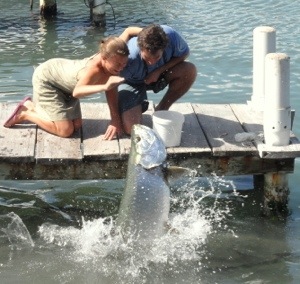
More bone-fishing was to be had back in Rock Harbour where I had the un-nerving experience whilst stalking a large solitary ‘Bone’ to find that I wasn’t the only hunter there as a Great Barracuda glided by me as I stood stock still. Of course I cast for it!
We fished all day, caught around 15 fish and headed back with stories, a tan and a few well deserved beer… If anyone reading this is planning a fishing trip here… bring some strong tackle. The Tarpon we encountered weren’t spooked by us at all as they never get fished and you can cast to the same fish time after time. We sadly didn’t see more permit as they prefer the deeper waters, but I was informed that to the West of Rock Harbour schools of 30lb Permit are regularly seen… A trip for next time…
Hand-Lining for Tuna!
The old boy, Desmond Johnson, who ran our little 4 room hotel, Relax Inn, took me fishing at 4.30am one morning. We had the deep sea rod in case we came across any Kingfish or Wahoo but our main target was Tuna for lunch using only a hand line!!
The Whale-sharks that arrive in May each year bring with them an entourage of Tuna and Bonito, which in turn attract Barracuda and Wahoo, only for the latter to be hunted by Tiger Sharks! Great opportunity for a swim!
We had barely been out of the bay for 30 mins before the Tuna chaos started! Desmond had one handline tied around his foot as he steered his dory around some deep sea mounts searching for the fish. The first couple were some small yellow-fin Tuna followed by 6 Bonito and as the 3rd and final hour of our trip was up, a decent Barracuda and an impressive black-fin Tuna that almost dragged my Utilian captain below the waves!
3 hours fishing and enough food to feed a family for weeks, or at least Clare & I for 5 days!
Some of the catch
Yellow-fin
Barracuda
Fishing in the Amazon
The River Amazon itself contains more than 2000 species of fish. From the small but powerful Red Bellied Piranha to the giant Red Tailed Catfish. Unfortunately due to the massive amount of water pouring down it, this makes it almost impossible to fly fish… I say almost!
The tributaries leading into the Amazon and the Oxbow lakes created by the annual flooding present all anglers, during the drier months, the opportunity to catch a vast number of species including most importantly for fly fisherman, The Tucu, aka The Peacock Bass. The aggressiveness of this fish has a deserved reputation. When the young are present, the parental insticts of the adults kick in and the Tucu have been known to attack any lure passed over or under them. Attack should really be replaced with smash here… The initial strike can be likened to that of a Tarpon, as it breaches the water almost every time and with such ferocity it easily snaps leader and tippet. The subsequent fight is thrilling. They will bolt for any obstacles in the water, sunken trees etc and will clear the water numerous times attempting to dislodge the hook. Suffice to say, if you land one, it’s an impressive feat.
The Oxbow lakes are also home to the legendary Pirarucu, Arapaima Gigas, the largest freshwater fish in the world. These goliath fish can reach in excess of 10 feet in length, I challenge any fly fisherman to even attempt catching these beasts. We had the luck to see a pair hunting in an small lake by our lodge and the speed at which such a large fish moves is alarming, add over 600lbs of maximum weight and you have a real river monster. Sadly due to lack of protection and massive over fishing these stunning fish are now endangered, partly due to trophy fisherman but mainly for the food markets as just 1 Arapaima can easily feed 70 people.
At the Orotongo lodge I got together with Anthony Giardenelli, the owner, a mad keen fisherman who has been out here for 8 years and is probably one of the worlds’ experts on the Amazon fish species. He specialises in Cat Fishing, which is understandable with over 1000 different species to choose from, their abundance and their place on the dinner menu.
We fished every day with live bait and in numerous locations along the vast Amazon River. In all we counted 14 species of Catfish and 2 freshwater stingrays.
Mota Catfish
Tiger Catfish
Amazon Stingray
Bait Casting
By far the most stunning for me was the Tiger Catfish, covered from head to tail with yellow and black stripes. But the variety and colours are very startling.
-The Armoured Cat Fish has armour plates along the entire body and can reach in excess of 50 kilos!
-The beautiful Sorubim Cat fish which has black and white hieroglyphic markings, poisonous pectoral fins and a flat head
-The Piraiba Catfish, reaching 450lbs in weight, (although largest caught on a rod stands at 295kilos)… the list goes on.
I learnt later that everyone’s favourite Geordie, Robson Green, came out for his Extreme Fishing adventure on the Amazon and Antony’s team reeled in one of the massive Piraiba Cat fish.
Whilst camping out in the jungle, I had the fortune to be rowed through one of the Ox-bow lakes near the lodge for Peacock bass. The lake itself was teeming with fish, as I found out when the Piranhas staring taking my lures! Some other species I had never seen before, but still with large teeth, were hell bent on devouring all my flies! Leader was snapped, flies were lost and the Peacock bass were dislodging the hooks but after 2 hours I finally landed my first. Sadly a lot smaller than I was hoping!
Combine this with Sloths, Squirrel monkeys and a multitude of Toucans, Hawks and parrots…
All in all this was a once in a lifetime fishing day.
Over the course of the next 4 days, Anthony took me out every afternoon and evening onto the Amazon where I was introduced to more of the bemoth catfish species during sunsets, rains and occasionally being surrounded by the Pink River Dolphins. All in all this was an amazing experience and one I would recommend if anyone is heading in this direction.
www. otorongoexpeditions.com
Caiman at Belem market, Iquitos
Heading out at sunset with Anthony
Sorbium Catfish
